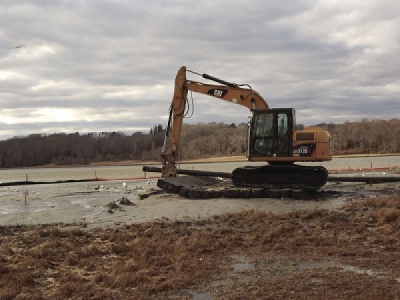
Posted on February 6, 2017
By Philip Cozzolino, The Narragansett Times
Commenced at the end of October, the Narrow River restoration project is nearing completion of its first phase. The dredging of the marsh river bed between Middlebridge and Sprague Bridge is expected to be completed by Tuesday, Jan. 31. At which point, at the end of February, the U.S. Fish and Wildlife Service, which owns the land, will begin to place the 24,000 cubic yards of dredged sand on top of 30 acres of the marsh, elevating the wetland to combat rising sea levels.
“Each of these areas that we have lined up to receive [dredged] material, also line up with an area in the river that will be dredged,” said Dr. Jennifer White, a biologist with the Fish and Wildlife Service. “This will help raise the elevation of the marsh so that it can last into the future and it also is going to make a central channel here.”
White said the dredging would open a new channel in the river, one that would allow recreational water sports, for which the area is popular in the summertime, to be moved away from the marsh. This, said White, would help decrease human impact on the marsh, including harmful propeller scars, or gashes in marshland caused by boat blades, that compromise the integrity of the land structure and allow more water in. White also said boat wakes being so close to the marsh was harmful due to the resulting waves constantly berating the marsh shores.
“The idea here is that there will be more of a center channel and that can get boat activity away from the edge of the marsh,” she said.
At a Narragansett Land Conservancy trust meeting taking place on Jan. 19, Narragansett Town Manager James Manni said the town was currently considering how many kayaks were entering the river during the peak activity months.
White spoke to the effect of sea level rise on the marsh’s habitat.
“‘One of the problems with sea level rise is that the water is coming up and there’s a switchover in vegetation from high marsh vegetation to low marsh,” she said. “And also higher tides, so birds are having their nests flooded out. Part of the reason why we’re raising the marsh to create a habitat for the birds, so that they are able to nest into the future.”
The project, funded through a federal grant for Hurricane Sandy relief, employs the services of a dredge machine and a 1,300-foot tube that carries sand and water to a location on the south end of the marsh, where the sand will later be collected for redistribution throughout the marshland. The project hopes to preserve and protect the habitat for threatened birds such as the saltmarsh sparrow, which only breeds in marshlands. Tim Mooney of The Nature Conservancy (TNC) elaborated on the wildlife.
“Dredging provides the sand we need for restoration purposes and improves habitat for juvenile fish, blue crabs, and other organisms, in part by creating conditions where eelgrass can thrive (grows in about 4 feet of water),” he said. “All of these critters fed the egrets and herons that spend the spring and summer at Chafee Refuge.”
The company that supplied the dredge machine, the first of its kind to be used in the United States, was Patriot Marine, a dredging company in Massachusetts, after a bidding process. The company custom-made some parts of the machine so as to not damage the marsh, as dredging typically takes place in much larger channels. Now, the dredging machine sits atop a barge about halfway between Middlebridge and Sprague Bridge, with two employees working 24 hours a day.
“The advantage of this over traditional dredging is that they claim it’s a higher percentage of sand to water ratio,” said John O’Brien, a biologist with the Fish and Wildlife Service. “They’re telling us that they are between 40 and 50 percent sand versus water. That’s pretty good in dredging circles.”
“They are dredging so many cubic yards and then assigning it to a location in need of dredged sand,” O’Brien continued. “And they can be right on with that.”
After dredging is completed, the sand will be placed along the marsh for elevation purposes by SumCo Eco Contracting. TNC is managing the contracts of the companies and handling the day-to-day logistical oversight of the project. The project also calls for the use of approximately 3,000 shell bags, set alongside the marsh shore to help block incoming water and keep the present sand in place. TNC collected the shells from local restaurants. The project is also utilizing the use of rocks around the marsh edge for similar purposes. In area where this tactic is employed frequently, the rock will eventually be covered by dredged sand to preserve the image and integrity of the marsh. U.S. Fish and Wildlife is also planting vegetation in appropriate areas and monitoring marsh levels to ensure the project is working and that the impact of the project does not negatively affect the area.
According to Mooney, TNC has written 30 contracts on the project, working together with U.S. Fish and Wildlife to expedite the process.
Officials said the warmer weather earlier in the month was fortunate, that dredging pipes could sometimes freeze during the cold winter months, delaying projects of this nature.
“Generally, if you get sub-zero weather, and they shut down, the pipe freezes up and they have to chain saw it and let it dry,” said O’Brien.
Officials said while the project is expected to be completed in marsh, it could be some two or three years before the marsh looks like regular, untouched marsh again, depending on a wide variety of factors.
“It’s probably not going to be pretty for a couple years,” said White.
Source: The Narragansett Times





